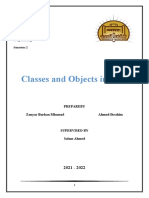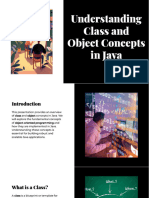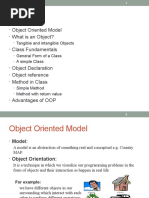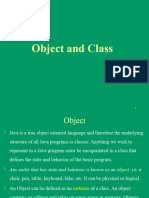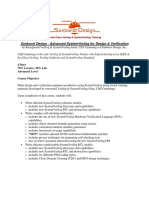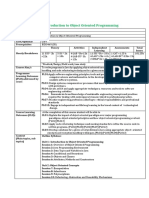Classes and Objects in Java
Uploaded by
sternford mavuchiClasses and Objects in Java
Uploaded by
sternford mavuchiClasses and Objects in Java
Classes and Objects are basic concepts of Object-Oriented Programming which revolve around the real-life
entities.
Class
A class is a user defined blueprint or prototype from which objects are created. It represents the set of
properties or methods that are common to all objects of one type. In general, class declarations can include
these components, in order:
1. Modifiers: A class can be public or has default access (Refer this for details).
2. class keyword: class keyword is used to create a class.
3. Class name: The name should begin with a initial letter (capitalized by convention).
4. Superclass (if any): The name of the class’s parent (superclass), if any, preceded by the keyword
extends. A class can only extend (subclass) one parent.
5. Interfaces (if any): A comma-separated list of interfaces implemented by the class, if any, preceded
by the keyword implements. A class can implement more than one interface.
6. Body: The class body surrounded by braces, { }.
Constructors are used for initializing new objects. Fields are variables that provides the state of the class and
its objects, and methods are used to implement the behavior of the class and its objects.
There are various types of classes that are used in real time applications such as nested classes, anonymous
classes, lambda expressions.
Object
It is a basic unit of Object-Oriented Programming and represents the real-life entities. A typical Java program
creates many objects, which as you know, interact by invoking methods. An object consists of:
1. State: It is represented by attributes of an object. It also reflects the properties of an object.
2. Behavior: It is represented by methods of an object. It also reflects the response of an object with other
objects.
3. Identity: It gives a unique name to an object and enables one object to interact with other objects.
Declaring Objects (Also called instantiating a class)
When an object of a class is created, the class is said to be instantiated. All the instances share the attributes
and the behavior of the class. But the values of those attributes, i.e. the state are unique for each object. A
single class may have any number of instances.
Initializing an object
The new operator instantiates a class by allocating memory for a new object and returning a reference to that
memory. The new operator also invokes the class constructor.
INSTRUCTOR: MR. S. MAVUCHI
CONTACT: 0718585317
EMAIL: smavuchi@hit.ac.zw
A Simple class
Here is a complete program that uses the Box class:
/* A program that uses the Box class.
Call this file BoxDemo.java
*/
class Box {
double width;
double height;
double depth;
}
// This class declares an object of type Box.
class BoxDemo {
public static void main(String args[]) {
Box mybox = new Box(); // object instantiation
double vol;
// assign values to mybox's instance variables
mybox.width = 10;
mybox.height = 20;
mybox.depth = 15;
// compute volume of box
vol = mybox.width * mybox.height * mybox.depth;
System.out.println("Volume is " + vol);
}
}
INSTRUCTOR: MR. S. MAVUCHI
CONTACT: 0718585317
EMAIL: smavuchi@hit.ac.zw
You might also like
- CS112 - Basic Concepts in Java (Objects and Classes)No ratings yetCS112 - Basic Concepts in Java (Objects and Classes)36 pages
- The Concept of Java Classes and ObjectsNo ratings yetThe Concept of Java Classes and Objects51 pages
- "Working With Class Programming in Java": A Term Paper Report OnNo ratings yet"Working With Class Programming in Java": A Term Paper Report On11 pages
- Unit 1 Class and Objects: Structure Page NosNo ratings yetUnit 1 Class and Objects: Structure Page Nos22 pages
- OOPs (Object-Oriented Programming System)No ratings yetOOPs (Object-Oriented Programming System)302 pages
- OOP (O - O P S) : S Bject Riented Rogramming YstemNo ratings yetOOP (O - O P S) : S Bject Riented Rogramming Ystem50 pages
- Java Oops Concepts: Oops (Object Oriented Programming System)No ratings yetJava Oops Concepts: Oops (Object Oriented Programming System)76 pages
- Object Oriented Programming Inheritance: Fundamentals and ApplicationsFrom EverandObject Oriented Programming Inheritance: Fundamentals and ApplicationsNo ratings yet
- Java Programming Tutorial With Screen Shots & Many Code ExampleFrom EverandJava Programming Tutorial With Screen Shots & Many Code ExampleNo ratings yet
- Syllabus Advanced Systemverilog TrainingNo ratings yetSyllabus Advanced Systemverilog Training12 pages
- EEI3262 Introduction To Object Oriented Programming - Course SynopsisNo ratings yetEEI3262 Introduction To Object Oriented Programming - Course Synopsis2 pages
- Task 4 - Solutions - Separate Chaining and RehashingNo ratings yetTask 4 - Solutions - Separate Chaining and Rehashing5 pages
- Mortennobel - Cpp-Cheatsheet - Modern C++ CheatsheetNo ratings yetMortennobel - Cpp-Cheatsheet - Modern C++ Cheatsheet13 pages
- JEDI Slides Intro1 Chapter 00 Introduction100% (1)JEDI Slides Intro1 Chapter 00 Introduction11 pages
- Top Java Interview Questions and Answer You Must PrepareNo ratings yetTop Java Interview Questions and Answer You Must Prepare16 pages






